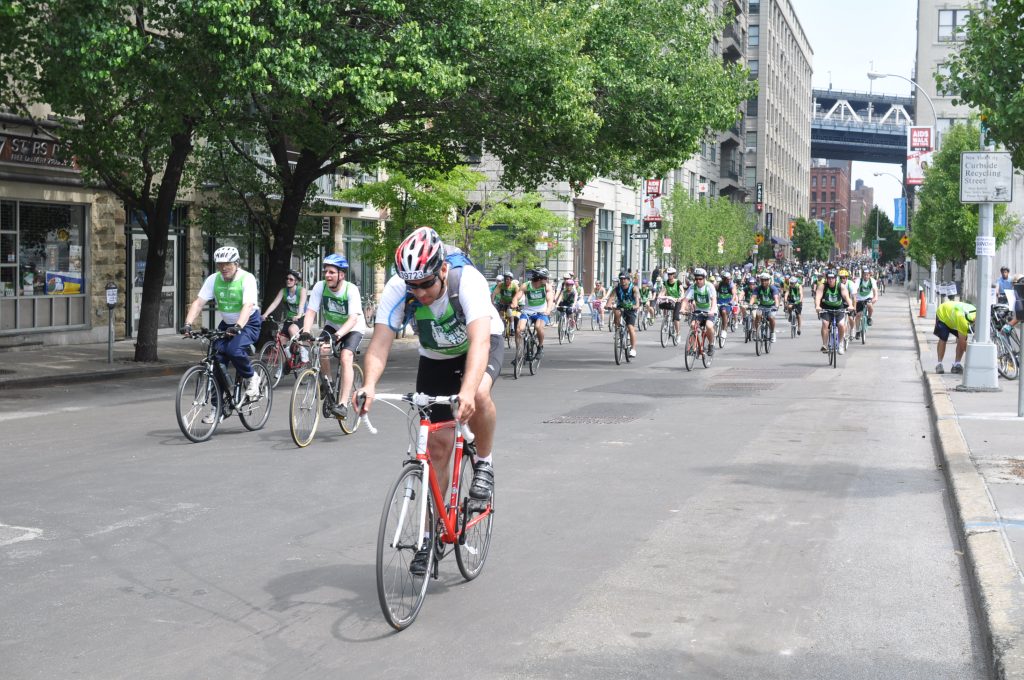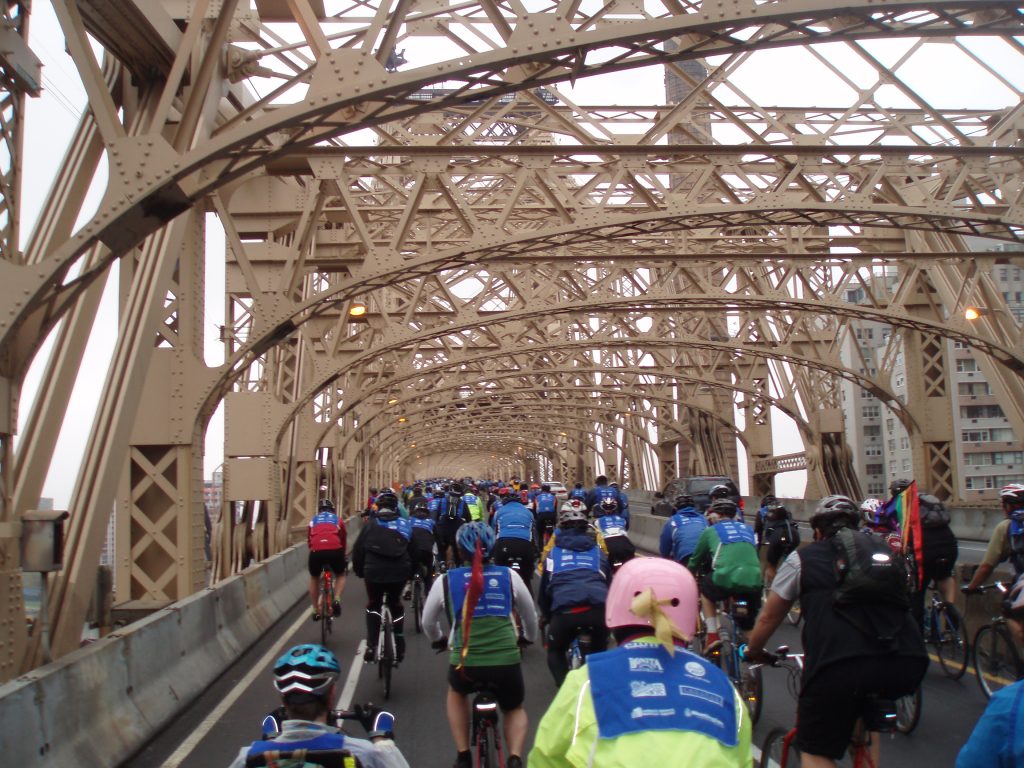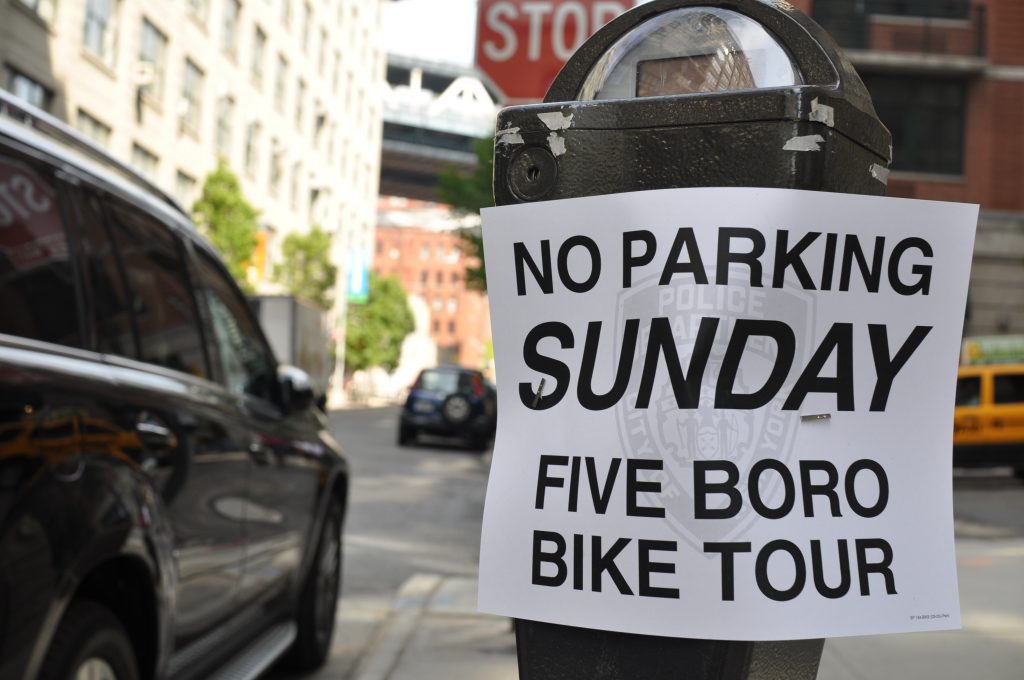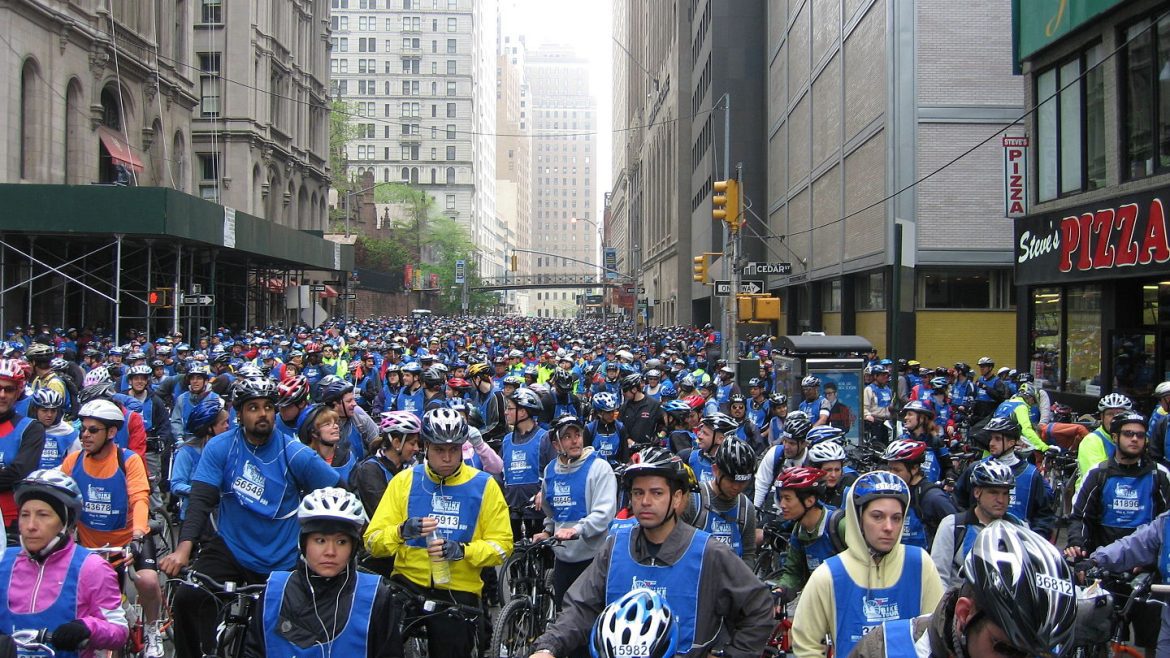From Couch to Bike New York
To a sedentary person, the 40+ miles of Bike New York could be seen as an accomplishment as daunting at the Tour de France itself. Worry not, even World Champions once thought a 40-mile ride was long. Prepare for Bike New York, prepare well, and the ride will be almost easy.
How you prepare for the Five Boro Bike Tour depends on which saddle you sit. Those used to riding daily probably won’t have to do anything special to get ready, while those new to cycling have to prepare both mentally and physically, as well as getting the right gear, and learning what cycling is along the way.
For the purpose of this article, we’ll assume you’re pretty new-ish to cycling. Maybe you have a bike, maybe you don’t, but you haven’t ridden regularly, at least in some time.
This Is About The Bike
To ride Bike New York, you need a bicycle, so this is the first order of business. Sure, some folks are visiting NYC and will rent for the ride, but a bike at home is essential. A derailleur-equipped bike with 26″, 650c, 27.5″ (650b), or 700c (29″) wheels are probably the best choices, though smaller wheels, like those on folding bikes or BMX bikes also work. Make sure the bike is in good working order. If you’re not sure, go to a bike shop and have them evaluate it. A yearly or even twice-annual bike check-up is a good thing to keep your bike running smoothly. Once you have it home, you’ll want to check tire pressure on a regular basis and keep an eye on the chain to make sure it isn’t getting rusty.
While at the shop, pick up a water bottle, water bottle cage, pump, spare tube, tire levers, patch kit, a multi-tool, and a small bag to pack it all in. A floor pump for pumping up your tires at home and some lube for the chain are also good things. If you don’t have a helmet, now is a great time to get one; helmets are mandatory at Bike New York. It’s pretty important to be able to change a flat tire on your own; ask the bike shop folks for a lesson if you don’t know; there’s always youtube if you’re afraid to ask.
This is about accessories
There are a few additional accessories that can make riding more comfortable. They aren’t necessities, but they can make riding more comfortable. Stiff-soled cycling shoes that attach via cleats to clipless pedals increase comfort, efficiency, and security on the bike. Padded cycling gloves take pressure off your hands. Padded bike shorts also add comfort by putting a little cush under your tush and also decreasing the likelihood of loose pant legs chafing your own legs. While these all can be ordered online, trying them on in person really makes a difference.

This Is About The Body
Next, it’s time to turn attention to your body. Just about everyone, with the right preparation, should be able to ride and finish the Five Boro Bike Tour. Those who have been sedentary for some time should first consult their doctor before embarking on any training plan. For the rest, how much training you need is a reflection of your fitness when you begin, your goal for the ride, and how much time you can devote to training.
With all physical training, the key is to start slowly and build gradually and consistently. If you’ve been afflicted with a serious case of couchpotatoitis, you might want to start building eight weeks out, which is early March. Try to exercise two to three times a week for at least a half-hour between Monday and Friday. What kind of aerobic activities you choose initially isn’t as important as simply doing aerobic activity itself. Sure, riding a bike, be it indoors or out, is good for specificity, but not so essential. Not yet.
Weekend Warrioring
The weekends are when you want to try building up some miles. Start by riding an hour at a pace that is comfortable one day on the weekend. How far have you gone? Let’s say you’ve done 10 miles. At that pace, you’ll cover the 42 miles of the ride in a little over four hours. Now look at how many weekends you have between this first ride and the big ride, and figure out how you can slowly increase your distance for that ride each week.
If you are able to manage 10, think about even increments of time or distance to your ride each weekend, until you’ve built to 40 miles on a single weekend day a week before the big ride. If that’s too complicated, start with 10 miles the first week, add four miles to the ride every week, and in eight weeks, a week before the 5BBT, you’ll have progressed to 42 miles.
For New Yorkers, finding a circuit three to six miles in length might be an easy way to add on miles. At three miles, you just add two laps a week, at six, add a lap. For example, Prospect Park is a bit over three miles around. Flushing Meadows a bit under five miles. Central Park a bit over six. (Blatant plug: These are just three examples: this site has rides of differing lengths in all five boroughs, New Jersey and Westchester.)
As the weeks progress, try to add a little exercise time each Monday-Friday week. Get at least one of those weekday workouts to be an hour in length. Make sure that at least one day is on the bike. Yes, there’s Soul Cycle and Peloton,some spin gyms, and indoor bikes. They’re all fine, but if you don’t have the cashish or the desire, or just don’t like the indoors, there’s always walking and running and other aerobic activities. Being active is more important than being specific, but some specific can help.
Testing and experimentation
As your rides get longer, start tinkering with on-bike hydration and nutrition. You don’t have to drink sports drinks and eat engineered energy bars if you don’t want to. Water is a fine beverage and fruit and/or cookies can work great for nutrition. All you need is a half-bottle to a bottle of liquid and 100-200 calories of something easily digestible every hour during a multi-hour ride. Drinking while riding is always a good thing, and should be done on short rides as well. Eating on the bike is something you don’t need to do until your rides are over two and a half hours. Don’t worry about this stuff during the 5BBT; there are aid stations along the way.
Turning The Pedals Is Just A Start
The phrase, “it’s just like riding a bike,” does cycling a disservice. Yes, it’s easy to ride, but riding well takes some skill. Most bikes have derailleurs so you can keep a fairly constant cadence whether going uphill or down. Yet, few people take full advantage of their low gears going up and their big gears going down. You want your legs turning over at a pace faster than walking, faster than jogging; 90 revolutions per minute (rpm) are considered an ideal cadence, a range of 80-100rpm is good, but beginners usually start at around 60rpm.. If you feel like your legs are moving slowly going uphill, keep on shifting into easier gears until you’ve either run out of gears or your legs are going around a bit too fast for comfort.
Behind derailleurs, the next most underutilized component on a bicycle is the front brake. The front brake is where all the braking power is, so squeeze both front and rear brakes equally when you want to slow down.
The Rest of the Ride
Between speeding up and slowing down is the rest of the ride. Here, it’s a good idea to keep your head up, scanning the road ahead, anticipating what’s coming up. This is true whether you’re riding on a busy street or a bike path, and definitely true when you’re riding with 30,000 cyclists. You start shifting before your cadence gets too slow or fast, you brake before turns and so you can slow down gradually. These two things are important on hills, and the bridges of New York are the biggest hills on the ride. The density of cyclists are such that you shouldn’t be surprised if you have to get off your bike and walk because riders have backed up on the entrance ramps. And save a little energy for the end; the toughest hill of the ride is the climb of the Verrazano Narrow Bridge into Staten Island.

Day-Of Checklist (Pack The Day Before)
Bike in good working order–you should know this a week before so you can schedule repairs if need be.
Helmet.
Pump (or CO2 Inflator).
Repair Kit (tube, patches, tire levers, multi-tool) all stuffed in an on-bike bag or backpack you’re carrying.
Water Bottle and Cage (One or two of each) or Hydration Pack.
Windbreaker.
Layers of clothing to keep the body comfy as the temperature changes. (It can be as cool as the low 40s, it can be raining.)
Body Prep:
Get a good night’s sleep Friday and Saturday. Have healthy dinners. Sleep as well as you can. Wake up in time to have a breakfast you know you can stomach. Allow an extra 30 minutes to get to the start.

The Grand Finale: Riding the 5BBT
On the big day, one of the biggest challenges is starting. It’s not every day that 30,000+ cyclists go on a ride together, so starting can take a little while. Dress in layers, and start with everything on; expect it to be a little chilly standing in the shaded canyons of lower Manhattan. But the start is a metaphor for the journey you’ve completed; just like when you started training in March, you’ll be shivering a bit, but the hard part is done. Now you can enjoy the ride.
The Start
It can feel slow and chaotic at the same time. Take a deep breath. Don’t feel you have to start out fast. You’ve got at least 40 miles to go.
The Bridges
I’m reiterating: the Queensboro and the Verrazzano are the biggest hills on the ride. The Queensboro, which is about a mile long starting from just off the FDR drive, often backs up at the start as people aren’t always in a sufficiently low gear to take in the gradient at the start. The Verrazzano is the last hill on the ride and it is pretty long, at 1.2 miles.
First timers aren’t always ready to climb it, typically for reasons of both physical and mental fatigue. Find a comfortable gear at the start. If it feels too easy after a few minutes, try a harder gear, and shift into harder gears until you find a comfortable amount of resistance. Going down can get pretty fast; control your speed before it gets too fast for you. The visual impression of descending the Queensboro is that it’s steeper an faster than the Verrazzano, though it’s probably about the same.
Getting Back
The Ferry lets you off at Whitehall terminal and is within a mile of the 1, 2, 3, 4, 5, 6 A, C, E, J, R, W, and Z trains. If you’ve got any energy left, take an easy spin home. In my experience, doing it all by bike feels more impressive. If you parked, you’ll have to ride to your car.
